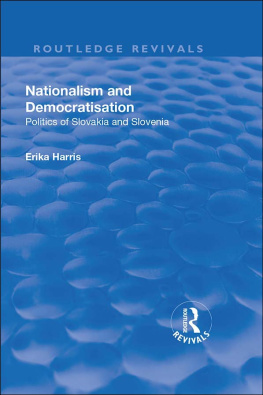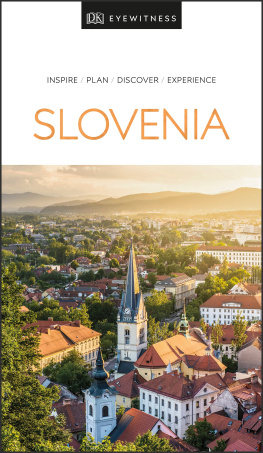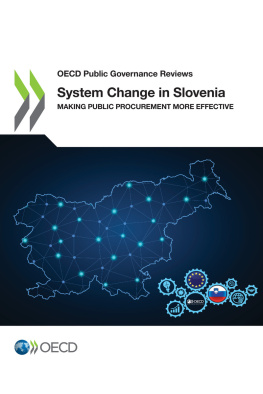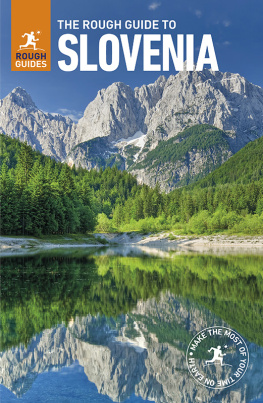Melania Trump:
The Slovenian Side of the Story
By
Sandi Gorisek
Melania Trump: The Slovenian Side of the Story
by Sandi Gorisek
http://www.melania-slovenianside.com
2017 Sandi Gorisek, Artice
Publisher: Self-published, 2nd edition
Publication Date: 9 January 2017; 2nd edition 24April 2017
Language: English
Document type: e-book
No. of copies: e-book
All rights reserved. No portion of this book may bereproduced in any form without permission from the publisher,except as permitted by U.S. copyright law. For permissioncontact:
Cover by Martina Semec Volovec
ISBN: 978-961-94161-2-9
FREE AUDIO BOOK AVAILABLE ON:
Melania - Slovenian side ofthe story eBook
FOLLOW US ON:
Facebook: @ Slovenianside
Twitter: @ sandigorisek
Instagram: @ Slovenianside
Table of Contents
Acknowledgments
First and foremost, I would like to acknowledge mysupportive family, which has always stood behind me and my crazyideas. Of the many positive things I learned while writing thisbook, the one that will stick in my memory for the rest of my lifeis the moment when I sat down with my parents to reveal what I haddone and then we had a six-hour talk about the good old times and then I rewrote the book.
Projects like this always serve to filter ones listof friends, and I feel blessed to be surrounded by friends thatwere willing to participate in the project. I cannot express mygratitude enough for the time you all dedicated to realizing thiswork, but let me try regarding the ones for whom I caused the mostproblems. Thank you Petra and Brian from the bottom of my heart for getting my engineering English to at a least decent level! Myfirst proofreaders, including Merrill and Katie: you restored myfaith in the general kindness of people since you are both only afriend of a friend in this project and you still did not hesitateto help me, despite the almost impossible deadline. To Martina, theoverall project and cover designer; to Iva, the officialphotographer who made me look good, which is not an easy task; andto Dominik, for the books dedicated website. Thank you for all thepatience and last minute corrections; it was a pure pleasure torediscover your and my own level of stress tolerance. Last but notleast, Niko: thank you for your patience regarding the last sevenversions and your narrative contribution on the last day. Withamateur actors such as you, we almost dont need real ones.
You all exceeded every expectation, not only asregards the quality of your work, but also and most importantly by showing me the true meaning of friendship. With friends like youevery project is pure pleasure!
I dedicate this book to my wonderful family. DearDanica, Franc, and Boris, you are my greatest love and I thank youfor having shown me what life is all about since day one..
Chapter zero:
Why, Oh Why
I was raised in the same rural environment ineastern Slovenia as the First Lady of the United States of America,just a few miles from her hometown. I would like to think that mydirect approach and understanding of the local mentality, inaddition to not having any political or professional connectionswith any governmental authorities or journalistic outlets arefactors that can positively contribute to this short and objectivestory about the country and its people. Sharing my youth on thesame hillsides, being raised by parents with very similar (if notidentical) backgrounds and values, and not having formed anypre-existing overview of the topics addressed herein are the mainreasons why this book simply needed to be written. Cheap tricks insearch of easy money and media exposure went so far that storiessuch as Communism is taking over the USA flooded everyday news,despite the average person now knowing that Cold War topics are ascurrent as the Roman Empire. Of course, older locals from thisregion did indeed live and were raised, at least in part, in asocialist state. That having been said, both my father andMelanias father joined the Communist Party for much the samereasons that people today become involved in politics, including inorder to increase their social capital and take a few shortcuts soas to provide a higher quality of life to their families. Ourmothers worked for the company Jutranjka, on the production line ofthe biggest youth clothing factory in ex-Yugoslavia, which helpedtheir children gain basic sewing skills and also led to Melaniasfirst exposure to modeling at a young age. This book is notintended to start an endless debate about the good old times.Rather, the aim of this book is to show how growing up in thisatmosphere created and nurtured beliefs from that time period thathave influenced all of us, including Mrs. Trump. By reading thisbook, one will gain a better understanding of the typical valuesand beliefs that were instilled in our subconscious by our parents,childhood friends, and environment. It will show that we are allunique and different, yet still more similar than most would thinkor even admit. By means of this overview, readers will gain a widerperspective on what one can expect from a typical Slovenian, whichI still consider Melania to be even now.
Introduction
Lets play a simple game called ExperimentalLottery in which you can win one million dollars, but the winnermust divide the winnings between himself or herself and the otherplayer, a perfect stranger. To win, you have to figure out whatportion would satisfy the stranger. The catch is that if thestranger refuses his or her share, you both end up with nothing andyou have only one chance to make an offer. In a real case scenario,computer-programed logic would settle for just some of the money,which is common sense since something is better than nothing, yetthe human mind would refuse anything below 20% of the total amount.This idea stems from a well-known experiment that David McRaneyexplains in his book You Are Not So Smart. Do you think that theshare you offer would change if you were raised in humblesurroundings with a state-driven economy in which everyone issupposed to be equal? How much would this differ if you were maleor female, if your parents were rich or poor, or if you were raisedin a rural or urban environment? Do you believe that this decisionwould be the same everywhere in the world? If not, then enjoy thisinside view of the Slovenian, ex-Yugoslav, rural environment of30-40 years ago, where common folk, such as the First Lady of theUSA, were raised.
Knowing the background of a person is certainly lesspowerful than a first impression, but, as will be revealed below,it is important if you want to understand someones actions andpredict his or her future actions. Later in this book you will seea few examples of how and when, in my opinion, our common Sloveniansoul did and once again will kick in. This is best illustrated by awell-known Slovenian saying that states that a wife supports threecorners of the house, which refers to how women influence men in amore profound manner than we can imagine. It is not too arrogant tosay that the future of the USA and its population will be partlytailored by the patterns and principles learned from the people ofa small, proud nation situated on the sunny side of the Alps.
Chapter one:
Tell Me Where You Come From and I Will Tell You WhoYou Are
This common Slovenian saying, in our case, refers tothe small town of Sevnica, a mediaeval town that shines betweenvine-clad hills on the left bank of the River Sava, located in theeastern part of Slovenia. The town has not changed much in the past40 years, and in the period before that it had developed, togetherwith other villages, in socialism. The population has increasedgradually, and now stands at todays astonishing 5,000 inhabitants,mostly due to individuals moving in from local villages, fuelingthe process of urbanization. Among the newcomers who built thetowns industrial base were Amalija (pronounced Amal-ee-ya; inSlovenian, j is pronounced like an English y) and Viktor Knavs,with their two daughters, Ines and Melanija (she subsequentlychanged the spelling to Melania) This post-World-War-Two town is atypical small industrial Slovenian town. It was designed around itspublic buildings, such as the schools and medical center, withindustrial facilities located in its so-called suburbs. Itsdevelopment was boosted first by the new railway connection in 1938and subsequently by the state-driven urbanization plan undersocialism. For readers who are not familiar with this type ofarchitecture, just type into your browser Tour Melania Trumpshometown in Slovenia to see a video by the ABC journalist LouiseDewast to gain a better understanding of what I am talking about.With a bit of imagination, which we all have in common, and a clickon your personal laptop time machine, you will discover a glimpseof where the First Lady grew up and was instilled with values thatwould serve her in ways that no one could ever have imagined. Foran even more authentic image, while watching this or any othervideo clip about Sevnica, keep in mind that 40 years ago all thebuildings were a pale gray.










